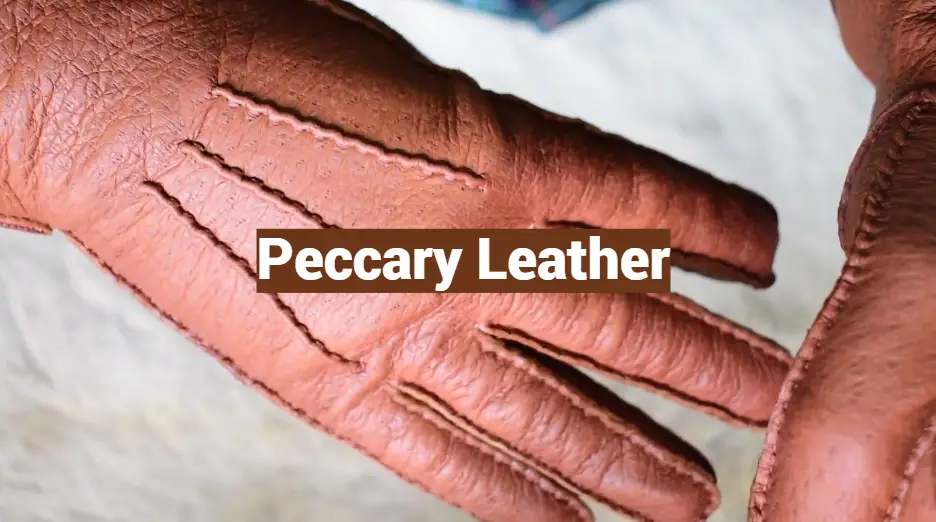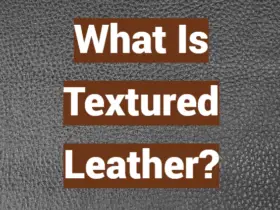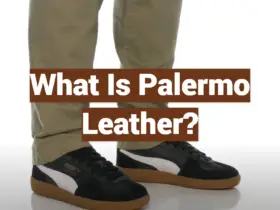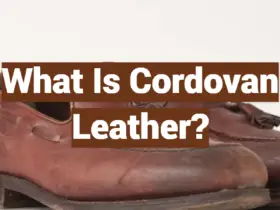Definition
A peccary is a small, nearly pig-like hoofed mammal. Often known as a javelin or a skunk pig, they come from the Tayassuidae animal tribe. They are located all over Central and South America and in North America’s southwestern region. A peccary is very close to the animals of the capybara species.
Peccary hides are very luxurious and Peru manufacturers consider them as the highest quality hides for sale. These leather hides are not very large. To begin with, a peccary is just around 35 – 52 inches in height. Therefore, these hides are not like an average cowhide, as you would expect, so they are used for the fashion industries.
There are many types of peccary leather. To name a few types, there are pigmented, chrome tanned, veg tanned, and crust finishes. Some peccary leather material even has hair, while the others are even and smooth. Artisans and manufacturers rely on the size of the animal’s hide and natural scars. Depending on these factors, they decide whether to tan or dye certain hides of peccary. However, almost all hides nowadays go through treatments to have a more interesting or peculiar finish.
The durability, flexibility and versatility of peccary leather are recognized and valued. This sort of leather is hard-wearing. For instance, peccary gloves may last a lifetime if handled with proper care. Since the material is quite durable and resistant, the daily usage is unlikely to damage peccary gloves.
As for the natural appearance, peccary leather has a smooth, grainy texture and can be recognized in groups of three by clear hair pores. Few farmers only choose to treat the peccary leather pieces taken from the back of the animal. This results in all the follicles being horizontal, providing a distinctive appearance and interesting texture. The leather also gets a glossy finish without any treatments in this case.
This natural leather also has scratches and other flaws, suggesting that this hide is authentic peccary leather since peccaries are feral animals living a rough existence. For a more realistic appearance, the peccary leather sold online is typically chrome-tanned and dyed in many colors. Though, if you stick to eco-friendly materials, use the peccary leather with vegetable tanning.
Is it Legal to Use Peccary Leather?
A peccary is an animal of medium size belonging to the species of wild pigs, slightly resembling the wild boar or warthog. As well as Central and South America, the Peccaries can be found in the southwestern regions of North America. They are feral creatures, but they are killed for their skins, not raised on special farms. The finest hides come from Peru’s wild peccaries.
That is why the legal shooting of peccaries is strictly regulated by the CITES Guidelines to ensure that peccaries are not slaughtered. According to these regulations, the national and international organizations make sure natural peccary hides are sustainable and their use would not affect the ecosystem. This regulation also implies that the availability of peccary hides as well as their prices.
Peccary Leather vs. Other Natural Leather Materials
If you don’t have a chance to find peccary leather, you may try to replace it with such materials:
- Carpincho;
- Deerskin;
- Elk leather;
- Reindeer;
The most related leather material is Carpincho, a form of big semi-aquatic rodent native to South America, which is derived from the Capybara’s species. Its leather texture is almost identical to suede. It is distinguished by its distinctive pore shape. Carpincho, like peccary, is well-known in the leather manufacture industry for its durability, softness and functionality. It is, however, less expensive than natural peccary leather since it is perceived to be lower inconsistency.
Deerskin, since it has tremendous strength and elasticity, is quite comparable to peccary leather. As it seems to get softer and more supple with time and use, deerskin is also a common material for gloves. It is also a little sensitive since the grain is brittle, but it often has a gritty look with a more grainy texture.
Peccary leather has several little bristles that are very characteristic and you won’t notice them in any other leather, unlike Nappa leather or kidskin (goatskin). It may be mistaken for hog skin or pigskin by certain persons, but peccary is more expensive. Also, it is smoother and very robust at the same time. Due to such reasons, it is called the finest glove leather you can buy today on the market.
Uses
Peccary leather is picked by DIY craftsmen and the most prestigious manufacturers. Typically, peccary gloves are the most favorite products made with this material. However, some manufacturers use it for making purses and wallets. You may create all sorts of fashion pieces from natural peccary leather pieces.
The limited uses are easy to explain. A peccary hide can only be cut properly by exceptionally skilled master glove cutters, resulting in a remarkably well-fitting piece. All premium peccary gloves must be hand sewn owing to the condition of the material.
For footwear, coats and belts this material is also picked. These products are aimed at the premium and luxury market, as predicted by such high-quality content.
One of the world’s most expensive and softest styles of peccary leather. Also, this leather material is commonly used for making luxury products such as wallets and keychains, shoes and dresses all over Europe and the United States.
Benefits of peccary leather:
- Supple;
- Incredibly soft;
- Fabulous patina;
- Unique fit;
- Comfort;
- Exotic;
- Luxurious;
At first, peccary leather is called a luxury and very trendy material for a number of reasons. Secondly, real peccary goods are long-lasting and the additional price you spend on them would be worth it. Because you won’t have to purchase another pair of gloves to replace a damaged pair that turned out to be prone to wear. Thirdly, this peccary leather is also comfortable and smooth – the longer you wear it, the better it feels.
As for the drawbacks of peccary leather, the items made of this material need certain care in order to keep them looking nice and preserve their fit. Compared with other widely used natural leather materials, it is still very pricey but also has a very unique appearance. It is acceptable for gloves, but not for furniture and other applications where the thicker leather material is required.
Care and Maintenance
You can maintain peccary leather by following certain basic guidelines in order to guarantee that your peccary gloves manage to provide you outstanding service for several years. Do not lubricate gloves except on the thumb area. Because this is where the signs of lubrication may appear in a few years.
Try not to make such gloves muddy, as the peccary’s grainy texture is moisture sensitive. Place the gloves on a towel in case they are wet and let them dry naturally without any heating source nearby. Another bit of advice is to strive to quit a day before wearing wet gloves.
It is quite difficult to clean peccary leather. Most experts recommend using only Marseille soap, you can wash them and dry them away from any heat source. To regain the original look of peccary leather gloves, then try them on daily.
Here is how you should clean peccary leather gloves:
- Very muddy leather gloves should be placed under running lukewarm warm;
- Please be cautious not to dry out the leather surface – use a gentle natural fat-free soap;
- Rub the soap onto your gloves and scrub it out under running water to ensure that the soap residue is gone;
- Now, gently pull them off;
- Squeeze out the excessive water softly after they are washed. Do not twist the gloves since it may damage them;
- Let them dry out now, ideally at room temperature, on a flat surface, without any heating sources nearby;
- After drying try to reshape them a little bit to bring the initial fit back;
Keep in mind that it may take your gloves several hours to dry and make sure to put them on a number of times during this process to reshape them on your hands after they are completely dry.
If the stain or dirt is mild, consider skipping getting them wet. On the contrary, gently brush on a talcum powder if a deeper color tends to be wet, and the stain would more certainly disappear.
Comparison of Indicators for Peccary Leather
This table provides a comparison of various indicators related to Peccary Leather, a type of leather derived from the skin of peccaries, which are small pig-like mammals native to the Americas. The table showcases key numerical data in the imperial system, shedding light on important factors associated with Peccary Leather.
The table below presents a comparison of different indicators that are relevant to Peccary Leather. The indicators include the average weight of a peccary, the size of peccary hides, the average price of Peccary Leather per square foot, and the durability rating of the leather. These indicators help in understanding the characteristics and value of Peccary Leather.
| Indicator | Value |
|---|---|
| Average Weight of a Peccary | 50 pounds |
| Size of Peccary Hides | 5-6 square feet |
| Average Price of Peccary Leather per Square Foot | $40-$50 |
| Durability Rating | 8 out of 10 |
In the table, the “Average Weight of a Peccary” indicates the average weight of a fully grown peccary, which serves as a reference for estimating the amount of leather that can be obtained from a single animal. The “Size of Peccary Hides” represents the typical area covered by the hides of peccaries and provides insight into the available surface area for leather production.
The “Average Price of Peccary Leather per Square Foot” indicates the approximate cost of Peccary Leather in the market. This price range may vary depending on factors such as quality, tanning process, and market demand. Lastly, the “Durability Rating” reflects the leather’s ability to withstand wear and tear, with a rating of 8 out of 10 suggesting a high level of durability.
Overall, this table offers valuable information for individuals interested in understanding the key aspects of Peccary Leather, including its origin, size, price range, and durability.
FAQ
How is peccary leather made?
Peccary leather is made through a complex tanning process that involves several steps. First, the hides of the peccary, which is a wild boar-like animal found in South and Central America, are obtained. The hides are then cleaned to remove any dirt, debris, and hair. Next, the hides are treated with chemicals to prevent decomposition and preserve the leather. This process is known as tanning. After tanning, the leather is dried, conditioned, and stretched to remove wrinkles and give it a smooth appearance. Finally, the leather is dyed, polished, and finished to enhance its color and texture.
What are the characteristics of peccary leather?
Peccary leather is highly regarded for its exceptional qualities. It is known for its softness, durability, and strength. The leather has a unique grain pattern with small, close-set hair follicles, which gives it a distinctive texture. Peccary leather is also highly flexible and resistant to abrasion, making it suitable for various applications. It has excellent breathability, allowing air to pass through, which makes it comfortable to wear. Additionally, peccary leather has a natural oil content that helps it repel moisture, keeping it resistant to water damage.
What are the uses of peccary leather?
Peccary leather is highly sought after for its premium quality and is commonly used in the production of luxury goods. It is frequently used in the manufacturing of high-end gloves, such as driving gloves and dress gloves, due to its softness, flexibility, and grip. Peccary leather is also utilized in the creation of upscale accessories like wallets, belts, and watch straps. Additionally, it can be found in high-quality footwear, including boots and shoes. The unique properties of peccary leather make it a preferred choice for individuals who value both style and durability in their leather products.
How does peccary leather compare to other types of leather?
Peccary leather is often considered one of the finest and most luxurious types of leather available. When compared to other leathers, such as cowhide or sheepskin, peccary leather stands out due to its exceptional softness and flexibility. It is significantly softer than cowhide, yet more durable than sheepskin. Peccary leather is also thicker and stronger than many other leathers, making it highly resistant to wear and tear. Additionally, its unique grain pattern and natural oil content set it apart aesthetically, giving it a distinctive look that is highly prized by leather enthusiasts.
How should peccary leather products be cared for?
To ensure the longevity of peccary leather products, proper care and maintenance are essential. Here are some guidelines to follow:
1. Keep the leather away from direct sunlight and excessive heat, as they can cause the leather to fade or become dry and brittle.
2. Avoid exposing peccary leather to water for prolonged periods or submerging it completely, as it can damage the leather.
3. Clean the leather regularly with a soft, dry cloth to remove dust and dirt. For stubborn stains, use a mild leather cleaner or saddle soap following the product instructions.
4. Apply a leather conditioner or cream to keep the leather moisturized and supple. This helps prevent cracking and maintains the leather’s natural luster.
5. Store peccary leather products in a cool, dry place, preferably in a breathable dust bag or cover, to protect them from dust and humidity.
By following these care instructions, you can preserve the beauty and quality of peccary leather products for years to come.
Is peccary leather ethical and sustainable?
Peccary leather is considered relatively ethical and sustainable compared to other types of exotic leathers. The sourcing of peccary hides is typically regulated to ensure that it comes from legal and sustainable channels. The animals are not bred specifically for their skins but are usually hunted as part of population control measures or for meat consumption. Furthermore, peccaries are not endangered species, which reduces concerns about their conservation status. However, it is crucial to source peccary leather from reputable suppliers who adhere to ethical and sustainable practices.
What is the price range of peccary leather products?
Peccary leather products are generally high-end and come with a corresponding price tag. The cost can vary depending on various factors such as the brand, craftsmanship, and design of the product. As a premium type of leather, peccary leather commands a higher price than more commonly available leathers like cowhide or sheepskin. Typically, peccary leather gloves can range from $200 to $500 or more, while other accessories like wallets or belts can be priced anywhere from $150 to $500 or beyond. The unique characteristics and quality of peccary leather contribute to its higher price range.
Can peccary leather be customized or personalized?
Yes, peccary leather products can often be customized or personalized to suit individual preferences. Many luxury brands or artisans offer customization options for their peccary leather items. This can include selecting specific colors, finishes, or adding personalized details such as monograms or embossed initials. Customization may involve additional costs and may require a longer lead time for production. It is advisable to inquire with the specific brand or artisan regarding their customization policies and possibilities for peccary leather products.
How long does peccary leather last?
With proper care and maintenance, peccary leather products have the potential to last for many years. Peccary leather is known for its durability and strength, making it highly resistant to wear and tear. The lifespan of peccary leather items can vary depending on factors such as frequency of use, exposure to harsh conditions, and the quality of craftsmanship. Regular cleaning, conditioning, and avoiding excessive exposure to sunlight or moisture can significantly extend the lifespan of peccary leather products. Additionally, timely repairs or professional refurbishment can help revitalize and prolong the use of peccary leather items.
Can peccary leather be repaired if damaged?
Yes, peccary leather can be repaired if it becomes damaged. The extent and type of damage will determine the repair options available. Minor issues such as small scratches or scuffs can often be remedied using leather conditioners, creams, or polishes designed to restore the leather’s appearance. For more significant damage like tears or deep scratches, it is advisable to seek the assistance of a professional leather repair specialist. They have the expertise and tools to perform intricate repairs and ensure the best possible outcome. Promptly addressing any damages and seeking professional repair can help prolong the life of peccary leather products.
Related Video: How To Find The Best Handmade Peccary Men’s Leather Dress Gloves
Final Thoughts
Thanks to durability, flexibility and interesting texture, peccary leather is a trendy, luxurious material picked by leather clothes and footwear makers. You can’t go wrong with peccary if you’re searching for high-end leather materials that should last for a lifetime. Though, make sure you purchase from a trustworthy vendor who can guarantee that you will receive natural peccary leather.







Leave a Reply